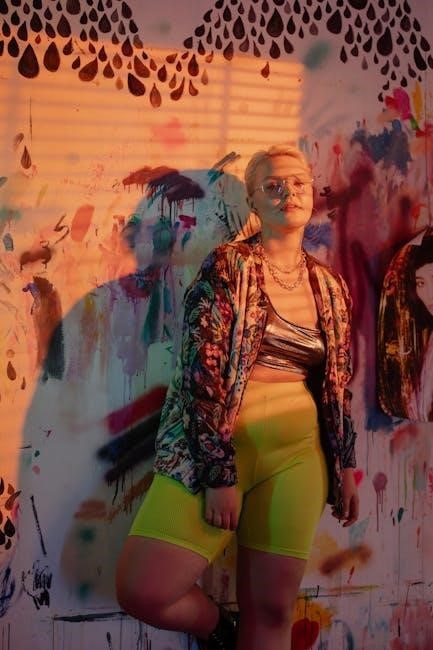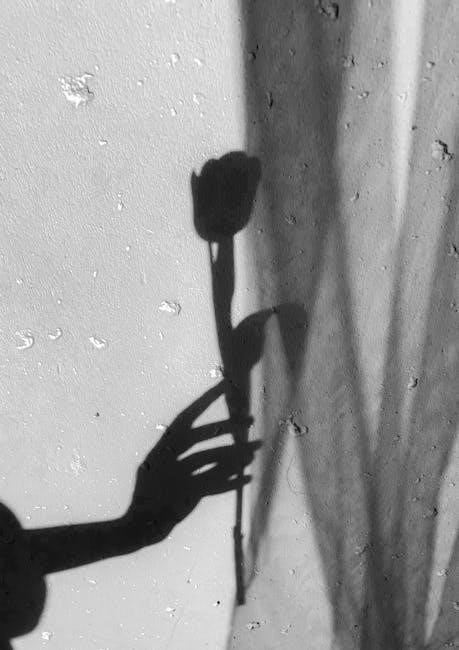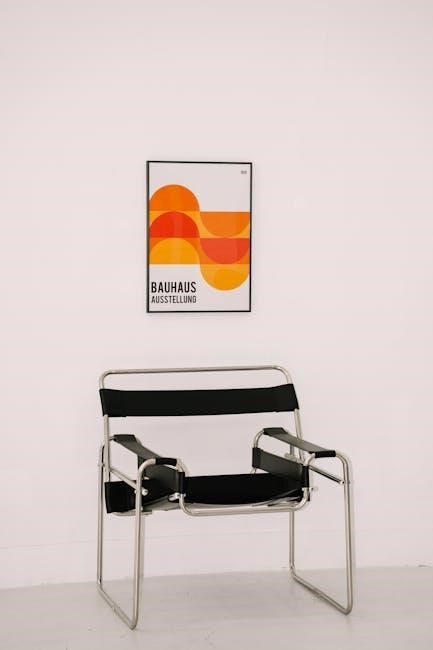Choosing the right wall art size enhances your space’s aesthetic. This guide helps measure walls, select proportions, and visualize placements using tools like painters tape for perfect harmony.
Importance of Choosing the Right Wall Art Size
Choosing the right wall art size ensures a balanced and cohesive space. Properly sized art enhances the room’s aesthetic, tying furniture, walls, and decor together. It creates visual harmony, preventing the space from feeling overwhelmed or underwhelming. The right size draws attention to focal points, complementing the room’s function and style. Whether for a living room, bedroom, or hallway, well-proportioned art elevates the ambiance, making it essential to select dimensions that align with the space and purpose.

Measuring Your Wall for the Perfect Fit
Measure your wall’s width and height to determine the ideal art size. Consider eye level placement and use tools like painters tape to visualize the art’s proportions before purchasing.
How to Measure Your Wall Space
Measure your wall’s width and height using a tape measure. Note the dimensions to ensure your art fits seamlessly. Consider the space above furniture or moldings. For eye-level placement, mark 57-60 inches from the floor. Use painters tape to outline the art’s potential size on the wall. Stand back to assess proportions and adjust as needed. Accurate measurements ensure a balanced and visually appealing display. This step is crucial for selecting art that complements your space perfectly.
Using Painters Tape to Visualize Art Size
Apply painters tape to your wall to outline the dimensions of the art you’re considering. This technique allows you to see how the size will look in the space. Stand back and evaluate the proportions. Adjust the tape as needed to find the perfect fit. This method helps avoid mistakes and ensures the art complements the room’s decor. It’s a simple yet effective way to visualize placement before committing to a purchase or installation.

Standard Wall Art Sizes
Standard wall art sizes range from small (8-13″ width, 10-19″ height) to large (40-60″ width/height), ensuring a perfect fit for any room’s proportions and decor style.
Small Wall Art Dimensions (8-13″ Width, 10-19″ Height)
Small wall art, with dimensions ranging from 8-13″ in width and 10-19″ in height, offers a subtle yet elegant touch. These petite pieces are ideal for small spaces, such as entryways or bathrooms, or for complementing larger art. They can also be grouped to create a cohesive display. Use painter’s tape to visualize their size on your wall before hanging. This ensures a balanced look and helps in selecting the perfect spot for these charming, understated works of art.
Medium Wall Art Dimensions (24-36″ Width/Height)
Medium wall art, sized between 24-36″ in width and height, adds a noticeable yet balanced element to any room. These pieces are versatile and can stand alone or be part of a gallery wall. They are particularly effective in spaces with average-sized furniture, providing a focal point without overwhelming the area. Medium-sized art is ideal for living rooms, dining areas, and hallways. Using a wall art size calculator ensures the perfect fit, while painter’s tape helps visualize placement before installation.
Large Wall Art Dimensions (40-60″ Width/Height)
Large wall art, ranging from 40-60″ in width and height, creates a bold statement and serves as a focal point in any room. Ideal for spacious areas, these pieces are often placed above sofas, beds, or fireplaces to draw attention. They complement large furniture and open spaces, ensuring visual balance. To ensure proper placement, use painter’s tape to mark the area, and hang the art at eye level, typically 57-60″ above the floor, for maximum impact and aesthetic harmony.
Placement Strategies for Wall Art
Hanging wall art at eye level (57-60″ above the floor) and centering it ensures a balanced, visually appealing display in any room.
Hanging Art at Eye Level (57-60″ Above the Floor)
Hanging wall art at eye level, typically between 57-60 inches above the floor, ensures that it is easily visible and balanced within the room. This standard height aligns with the average human eye level, creating a harmonious visual experience. It also unifies the space by drawing attention to the artwork without overwhelming the surroundings. For rooms with varying ceiling heights or unique layouts, adjusting the placement slightly can enhance the overall aesthetic. Centering the art on the wall further emphasizes its focal point, making the space feel cohesive and well-designed. This approach works beautifully in both modern and traditional settings, ensuring the art complements the room’s decor. Additionally, using painter’s tape to mark the area before hanging can help visualize the final look, ensuring satisfaction with the placement. Properly positioned wall art elevates the ambiance, making it a key element in interior design. By adhering to this guideline, homeowners can achieve a polished and thoughtfully curated environment. The eye-level rule is versatile, applying equally to small, medium, and large wall art, ensuring each piece enhances the room’s functionality and beauty. Whether above a sofa, fireplace, or bed, this placement strategy guarantees that the art is both admired and appreciated. Balancing practicality with aesthetics, hanging art at eye level is a fundamental principle in creating a visually appealing space. It ensures that the artwork is accessible, engaging, and harmonious with its surroundings, ultimately enriching the room’s design. This simple yet effective strategy is a cornerstone of successful wall art placement, offering a timeless solution for any interior. By following this guideline, individuals can confidently select and display their wall art, knowing it will contribute to a refined and inviting atmosphere. The eye-level standard is a universal approach that adapts to diverse styles and spaces, ensuring that wall art is both functional and visually stunning. It is a key consideration in the wall art size guide, providing a reliable framework for achieving a beautiful and balanced home decor. This straightforward yet impactful technique is essential for anyone looking to enhance their living spaces with well-placed wall art. By prioritizing eye-level placement, homeowners can create a space that is both elegant and engaging, where every piece of art tells a story and contributes to the room’s overall charm. This tried-and-true method ensures that wall art is not only seen but also appreciated, making it a vital element in any successful interior design plan. The eye-level rule is a testament to the importance of thoughtful placement in creating a home that is as functional as it is beautiful. By adhering to this simple principle, individuals can transform their walls into canvases that reflect their personal style and enhance their daily lives. The impact of properly hung wall art is undeniable, and starting with the right placement is the first step toward achieving a space that feels truly special. This fundamental strategy is a must-know for anyone aiming to elevate their home’s aesthetic and create a lasting impression. The combination of practicality and creativity makes eye-level placement a cornerstone of effective wall art display, ensuring that every piece is enjoyed to its fullest potential. In conclusion, hanging wall art at eye level is a simple yet powerful way to enhance any room, offering a balance of form and function that elevates the overall design. This timeless approach remains a cornerstone of interior design, providing a reliable guide for anyone seeking to create a beautiful and harmonious living space. By following this principle, individuals can ensure their wall art is both admired and integral to the room’s ambiance, achieving a perfect blend of style and practicality. The eye-level standard is a key component of the wall art size guide, offering a clear and effective path to stunning interior design. It is a principle that transcends trends, ensuring that wall art remains a central and cherished element in any home. This straightforward strategy is a must for anyone looking to make the most of their wall art and create a space that truly reflects their personality and style. By focusing on eye-level placement, homeowners can unlock the full potential of their wall art, transforming their spaces into vibrant and inviting environments. This essential technique is a fundamental part of the wall art size guide, providing a solid foundation for achieving a beautifully designed home. It is a testament to the power of thoughtful placement in creating spaces that inspire and delight. The eye-level rule is a time-tested method that ensures wall art is both functional and aesthetically pleasing, making it a vital consideration for any interior design project. By adhering to this principle, individuals can create a home that is as beautiful as it is livable, where every piece of wall art contributes to a cohesive and engaging whole. The impact of proper placement cannot be overstated, and starting with eye-level hanging is the first step toward achieving a space that feels truly special. This simple yet effective strategy is a must-know for anyone aiming to enhance their home’s aesthetic and create a lasting impression; The combination of practicality and creativity makes eye-level placement a cornerstone of effective wall art display, ensuring that every piece is enjoyed to its fullest potential. In conclusion, hanging wall art at eye level is a simple yet powerful way to enhance any room, offering a balance of form and function that elevates the overall design. This timeless approach remains a cornerstone of interior design, providing a reliable guide for anyone seeking to create a beautiful and harmonious living space. By following this principle, individuals can ensure their wall art is both admired and integral to the room’s ambiance, achieving a perfect blend of style and practicality. The eye-level standard is a key component of the wall art size guide, offering a clear and effective path to stunning interior design. It is a principle that transcends trends, ensuring that wall art remains a central and cherished element in any home. This straightforward strategy is a must for anyone looking to make the most of their wall art and create a space that truly reflects their personality and style. By focusing on eye-level placement, homeowners can unlock the full potential of their wall art, transforming their spaces into vibrant and inviting environments. This essential technique is a fundamental part of the wall art size guide, providing a solid foundation for achieving a beautifully designed home. It is a testament to the power of thoughtful placement in creating spaces that inspire and delight. The eye-level rule is a time-tested method that ensures wall art is both functional and aesthetically pleasing, making it a vital consideration for any interior design project. By adhering to this principle, individuals can create a home that is as beautiful as it is livable, where every piece of wall art contributes to a cohesive and engaging whole. The impact of proper placement cannot be overstated, and starting with eye-level hanging is the first step toward achieving a space that feels truly special. This simple yet effective strategy is a must-know for anyone aiming to enhance their home’s aesthetic and create a lasting impression. The combination of practicality and creativity makes eye-level placement a cornerstone of effective wall art display, ensuring that every piece is enjoyed to its fullest potential. In conclusion, hanging wall art at eye level is a simple yet powerful way to enhance any room, offering a balance of form and function that elevates the overall design. This timeless approach remains a cornerstone of interior design, providing a reliable guide for anyone seeking to create a beautiful and harmonious living space. By following this principle, individuals can ensure their wall art is both admired and integral to the room’s ambiance, achieving a perfect blend of style and practicality. The eye-level standard is a key component of the wall art size guide, offering a clear and effective path to stunning interior design. It is a principle that transcends trends, ensuring that wall art remains a central and cherished element in any home. This straightforward strategy is a must for anyone looking to make the most of their wall art and create a space that truly reflects their personality and style. By focusing on eye-level placement, homeowners can unlock the full potential of their wall art, transforming their spaces into vibrant and inviting environments. This essential technique is a fundamental part of the wall art size guide, providing a solid foundation for achieving a beautifully designed home. It is a testament to the power of thoughtful placement in creating spaces that inspire and delight. The eye-level rule is a time-tested method that ensures wall art is both functional and aesthetically pleasing, making it a vital consideration for any interior design project. By adhering to this principle, individuals can create a home that is as beautiful as it is livable, where every piece of wall art contributes to a cohesive and engaging whole. The impact of proper placement cannot be overstated, and starting with eye-level hanging is the first step toward achieving a space that feels truly special. This simple yet effective strategy is a must-know for anyone aiming to enhance their home’s aesthetic and create a lasting impression. The combination of practicality and creativity makes eye-level placement a cornerstone of effective wall art display, ensuring that every piece is enjoyed to its fullest potential.
Centering Art on Empty WallsCentering wall art on empty walls creates a balanced, polished look. Use painter’s tape to mark the area before hanging, ensuring the piece is both vertically and horizontally aligned. For a cohesive appearance, the center of the art should be at eye level (57-60″ above the floor). This placement draws focus to the artwork, making it the room’s focal point. Proper centering ensures harmony, preventing the space from feeling cluttered or uneven. It’s especially effective for large or statement pieces, enhancing the room’s aesthetic and creating a sense of calm. This technique works well in minimalist and traditional settings alike, making it a versatile choice for any interior design style.
Room-Specific Wall Art Size Considerations
Room-specific wall art sizing ensures harmony with space functionality. Measure furniture and walls to select art that complements the room’s purpose, enhancing its aesthetic and usability.

Living Room: Sofa and Fireplace Wall Art Sizes
In the living room, wall art sizing is crucial for creating a balanced atmosphere. Above the sofa, choose art with a width of 2/3 to 3/4 of the sofa’s length, leaving 6-12 inches on each side. For fireplaces, opt for large pieces or gallery walls covering 50-75% of the visible space. Ensure art is hung at eye level (57-60″ above the floor) to draw attention and enhance the room’s focal points. This approach ensures harmony with furniture and decor, making the space visually appealing and cohesive.

Bedroom: Wall Art Above the Bed
When selecting wall art for above the bed, choose pieces that complement the room’s intimacy. The art should be proportional to the bed’s size, typically covering 40-60% of the bed’s width. For a standard queen-sized bed, opt for art measuring 40-50 inches wide. Use painters tape to visualize the size before hanging. Place the piece at eye level, around 57-60 inches above the floor, to create a calming focal point. Ensure the art’s scale aligns with the room’s decor for a harmonious and inviting atmosphere.
